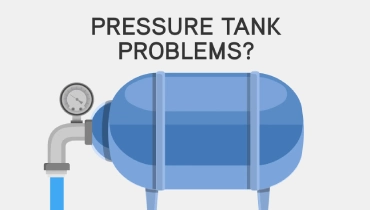
Mr. Rooter Plumbing explains how to address common pressure tank problems.
|
If you have a private well, then you almost certainly have a well water pressure tank. It’s the component that stores the water from your well, pressurizes it with air, and delivers it throughout your home. If you have pressure tank problems, then you likely have water pressure problems in several fixtures. The good news is that Mr. Rooter® Plumbing has you covered with the information you need to resolve pressure tank problems.
How Does a Water Pressure Tank Work?
A water pressure tank in your well system works by combining air pressure and a water pump to deliver water to the faucets, shower heads, toilets, and appliances in your home. A pump pulls water into the bottom of the tank, leaving room for air at the top. As the water level rises in the tank, the air at the top becomes increasingly compressed. When you turn on a water tap in your home, that compressed air pushes the water out of the tank, through the pipes, and out through the faucet.
Bad Pressure Tank Symptoms
Water pressure tank problems often make themselves known suddenly and without warning. However, there are a few symptoms you might notice earlier on that could indicate you have a problem with the pressure tank. Including the following:
- Frequent, widespread water pressure fluctuations.
- Multiple faucets that spit water instead of providing a steady stream.
- Clicking sounds that seem to come from the pressure tank.
- Increasing electric bills due to a failing check valve, causing the well pump to run constantly.
Related Topic: How to Increase Water Pressure in the Shower
Well Pressure Tank Troubleshooting Tips
Water pressure problems are irritating, but you don’t have to put up with them. Before calling a licensed plumber for service, try these easy well pressure tank troubleshooting tips to see if the problem has a simple issue.
- Make sure your main water valve is all the way open.
- Check your property for signs of any water leaks, including underground leaks. Steady leaks can make the pressure tank struggle to keep up with the household’s water demand.
- Check your water pressure using an air pressure gauge, which can be purchased at any hardware or home improvement store. Well water pressure should be somewhere between 40 and 60 pounds per square inch (PSI).
- Gently shake the pressure tank to see if you can hear any water sloshing around in it. If there’s no water in the pressure tank, it’s time to call a plumber to service or replace the unit.
Professional Service
If you’re experiencing any of the pressure tank symptoms listed above, don’t wait to restore the water pressure in your home. The team of professionals at your local Mr. Rooter Plumbing are trained and equipped to help. And because we’re part of the Neighborly family of home services, you know you can count on us to deliver outstanding service. Give us a call or request a job estimate to get started.

